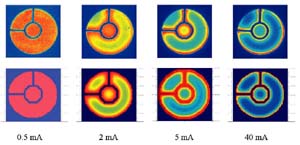| 2004 |

|
YEAR BOOK |
University College Cork
|
NMRC
|

Microtechnologies
Microtechnologies research addresses the development of future microelectronics and microsystem platform technologies. Key research programmes are being pursued in modelling and simulation; materials, processes and technologies; devices and reliability; packaging and integration. Recent results include:
-
�
Surface Chemistry Simulations for Atomic Layer Deposition
A vital aspect of 'Moore's Law' is the introduction of new materials into electronic components. Previously relying on trial and error, NMRC simulations are now revealing the surface chemistry dynamics that govern Atomic Layer Deposition (ALD) of oxide films just a few atomic layers thick. These simulations provide an important insight into the behaviour of hydrogen on oxide surfaces, which is notoriously difficult to probe experimentally. Extending these insights, efficient deposition of many other technologically important materials will become possible.
-
One Billion Cycles for a Capacitive RF Microswitch
Capacitive micro-mechanical switches offer substantial advantages over their semiconductor counterparts, such as low power consumption, very high isolation, low insertion loss and linear performance. However, to date, the dominant failure mechanism has been dielectric charging. A low-voltage switch, developed at NMRC, overcomes this problem and lifetime testing has exceeded one billion cycles without failure.
Photonics
Photonics research is focused on the development of core platform technologies in the areas of light sources, interconnect and biophotonics, along with complimentary research activities in modelling, characterisation, and novel photoprocessing. Recent results include:
-
�
Modelling of Quantum Dot Semiconductor Optical Amplifiers
In the area of semiconductor optical amplifiers (SOA), we have shown that, because the band structure of semiconductor QD material is markedly different to that of quantum wells and bulk materials, the high-speed characteristics of QD SOAs should be significantly better than those of the present generation of SOAs, based on quantum well and bulk materials.
-
�Low Cost Semiconductor Lasers
Photonics can provide the desired bandwidth for high-speed internet applications, but it is clear that, in getting bandwidth to the customer, cost is the major inhibiting factor. NMRC has previously developed a single frequency laser based on a much simplified fabrication process compared to conventional approaches. Recently, new designs were developed and applied to obtain multiple single wavelength sources from the same material on the same laser bar.
-
Visible Light Sources
NMRC is a world leader in the development of red VCSELs (vertical cavity surface emitting lasers) and resonant cavity LEDs (RCLEDs), and continues to add new designs for improved temperature performance and added functionality. NMRC has now developed methods to improve the light output and linearity of the RCLEDs through controlled current injection. The devices in the blue-green region, based on GaN, have achieved record bandwidth in plastic optical fibre systems, while a new design has improved the extraction efficiency.

Nanotechnology
Nanotechnology research is focused on the design and development of novel nanoscale materials, structures and devices that will provide innovative solutions to the demanding challenges of future ICT. Recent results include:
-
Nanocrystal-Based Electronic Devices
Organically passivated nanocrystals with diameters in the range 2-10 nm can behave as 'artificial atoms'. We have fabricated nanocrystal electronic devices using nanolithography and self-assembly. Recent work has focused on manipulating inter-nanocrystal electronic coupling mechanisms in nanocrystal devices. We have demonstrated that device transport properties may be tuned from Mott insulating through a critical regime to metallic behaviour. This result is a significant step towards reliable control of nanocrystal-based device fabrication.
-
Molecular Photonic Logic Gates
Demonstration of molecular level electronic functionality currently focuses on implementation of two terminal devices. NMRC has developed single molecule devices that combine multiple, individually addressable switch functions in one molecule. For the first time, we have shown intra-molecular digital logic (NOR) functionality by using electronic and chemical inputs to alter the fluorescent output of ruthenium polypyridyl complexes, self-assembled on a semiconductor surface.
ICT/BIO
ICT/Bio is a cross-disciplinary field of research at the interface between microtechnologies and the biological and chemical sciences. Our goals are to develop integrated microsystems for clinical and environmental diagnostics, to develop technology platforms for research applications in genomics and proteomics, and to apply our fabrication and integration expertise to novel solutions for in-vivo therapeutics. Recent results include:
-
Novel DNA Detection Device
A 'PIN' photodiode has been employed, for the first time, to measure DNA hybridisation events. This device is ideally suited for the 'Point-of-Care' diagnostics market when incorporated as part of a handheld microsystem-based instrument, and is currently being developed as part of a research programme for the rapid diagnosis of infectious diseases.
-
Targeted Electro-chemotherapy for Localised Cancer Treatment
NMRC is involved in the development of electrode-based microsystems for localised, electroporative gene therapy of cancers. Three types of microelectrode arrays are being fabricated at NMRC, namely planar silicon electrodes, polyimide-based flexible electrodes, and silicon micro-needle electrodes. The microneedles were fabricated by both wet and dry etch processes. DRIE-etched silicon needle arrays up to 150�m in height have been demonstrated, and a process for the formation of metal electrodes on the needles has also been established.
Contact: Professor Gabriel Crean, Director, NMRC;
Tel: +353 21 4904171; E-mail: [email protected] ; Web: http://www.tyndall.ie/